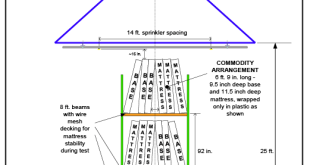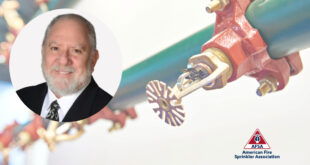The input stage for NFPA 13R and NFPA 13D has concluded, and the first draft report is available on NFPA’s website. As codes and standards are updated, many will not realize the impact of changes until their jurisdiction catches up three, five, or even 10 years down the road. By that time, it is too late to make additional changes, and the referenced standards are another three, five, or even 10 years ahead of the adopted codes. That is why it is so important to keep up with changes to the standards that affect your business the most—even if you are not currently using that edition. The column provides an inside baseball account of the standard development process and the proposed changes during each revision cycle with the intent of giving our members the information necessary to create their own public inputs (PI) and public comments (PC) based on their individual experiences, and details significant first revisions (FR) to NFPA 13R and NFPA 13D.
ANOTHER YEAR, ANOTHER REORGANIZATION
CI-23 NFPA 13R-2022; CI-37 NFPA 13D-2022
There are now three things that are certain in this world—death, taxes, and the reorganization of your favorite NFPA standard. This proposed change will not jump out at you in the first draft report as this change was moved as a committee input (CI) in both documents. The reorganization looks to emulate the structure of NFPA 13 that puts chapters in a logical order that follows the design and construction process from beginning to end. CI-37 includes a new skeleton for NFPA 13D with 18 chapters. A similar, but yet-to-be-published list of chapters for NFPA 13R should be available for public comment by mid-March and included in CI-23. For those keeping score, a committee input is a proposed change that was not quite ready for prime time but is included in the first draft report for public comment. To be included in the next edition, the technical committees will have to make second revisions during the public comment stage—otherwise the CI will die.
CORRELATING DEFINITIONS WITH NFPA 13
FRs in Chapter 3 of NFPA 13R and NFPA 13D
Over the years, there have been common terms defined in NFPA 13, NFPA 13R, and NFPA 13D that had slightly different language depending on the standard. This revision cycle, the committee is looking to clean up those common definitions and correlate with NFPA 13 by extracting the definitions, where appropriate. The extraction process is beneficial as all extracted definitions will be automatically updated in future revision cycles, and unintended contradictions when applying definitions from the different standards will be eliminated.
K-FACTOR OF REPLACEMENT SPRINKLERS
FR-5 NFPA 13R-2022; FR-41 NFPA 13D-2022
When replacing sprinklers, the new sprinkler must match the performance characteristics of the sprinkler being replaced. That includes the flow rate, pressure, area of coverage, and the K-factor. Prior to the 2002 edition of NFPA 13R and NFPA 13D, there was no minimum 0.05 gpm/ft2 density requirement and the standard relied on the sprinkler manufacturer’s listing instructions. After the 0.05 gpm/ft2 density was mandated, the standard allowed the old sprinkler manufactured prior to 2003 to be replaced with a sprinkler that matched the performance characteristics, but the K-factor was permitted to be within ± 5 percent to accommodate the change in minimum density between editions. The new language in the first draft reports of NFPA 13R and NFPA 13D now allows for the sprinkler to be within ± 5 percent or the next larger K-factor.
5.1.1.2* Sprinkler Replacement.
Where replacing residential sprinklers manufactured prior to 2003 and that are no longer available from the manufacturer and are installed using a design density less than 0.05 gpm/ft2 (2.04 mm/min), a residential sprinkler with an equivalent K-factor (± 5% 5 percent or next larger K-factor) shall be permitted to be used provided the currently listed coverage area for the replacement sprinkler is not exceeded.
The initial 5 percent allowance was arbitrary and the new provision to allow the next higher K-factor available eliminates a procurement issue when there were no available sprinklers within the 5-percent range. The committee justified this change by stating, “A sprinkler with a slightly larger K-Factor will allow the space to be protected with a slightly larger flow when the first sprinkler activates.”
LED EXCEPTION
FR-12 NFPA 13R-2022; FR-6 NFPA 13D-2022
Thomas Edison invented the incandescent lightbulb in 1880, but since then other types of lightbulbs that are not the standard incandescent bulb have been developed. Those other types include halogen bulbs, compact fluorescent lamps, and light-emitting diode (LED). The most noteworthy lightbulb of the bunch is the LED which offers an energy savings as well as lower operating temperatures. Due to the cooler LED lightbulb, NFPA 13R and NFPA 13D now make the distinction to exempt LED light fixtures from the minimum spacing from heat sources. Go ahead and use an ordinary temperature-rated sprinkler as close as you want to the LED lightbulb, but don’t forget about the obstruction rules and that intermediate temperature-rated sprinklers are permitted to be installed throughout residential occupancies so you don’t have to worry about these small details.
A CLOSET IS A CLOSET
FR-15 NFPA 13R-2022; FR-42 NFPA 13D-2022
Over the last year, AFSA has fielded several technical questions asking if sprinklers are required in small closets that do not have doors. This common question was the impetus for one of AFSA’s public inputs to the residential committee, and the proposal was accepted with the following language:
6.6.3 Except where specified in 6.6.4, sprinklers shall not be required in clothes closets, linen closets, and or pantries with or without doors within dwelling units that meet all of the following conditions:37
(1) The area of the space does not exceed 24 ft2 (2.2 m2=2).
(2) The walls and ceilings are surfaced with noncombustible or limited-combustible materials as defined by NFPA 220.
(3) The closets without doors meet the definition of a compartment (see 3.3.4 ).
The committee agreed with AFSA’s technical substantiation stating, “Whether a door is present or not, it does not change the use of a clothes closet, linen closet, or pantry as long as it meets the definition of a compartment.” It should be noted that the scope and purpose of NFPA 13R and NFPA 13D have a greater focus on life safety than property protection, so there are additional allowances where sprinklers can be omitted in spaces that have low occupancy, low risk of fire, and do not impede the egress of people out of the building.
EXPANSION TANKS AND EXPANSION CHAMBERS
FR-2 NFPA 13D-2022
In addition to some editorial and clerical revisions, there were changes specific to NFPA 13D that are worth noting. The first change clarifies that no matter what you call an expansion tank, it does not have to be listed for NFPA 13D systems. Again, NFPA 13D systems aim to provide a cost-effective system that’s sole purpose is for life safety. To provide cost-effective systems, several system components are not required to be listed in NFPA 13D systems — this includes expansion tanks. The issue AFSA uncovered was that expansion tanks are required to be listed in NFPA 13 systems; so, to differentiate, the residential committee changed the name to “expansion chambers” several cycles ago. The only problem was that it was changed in the entire standard except section 5.1.2.1. Section 5.1.2.1 was revised this revision cycle to state that expansion tanks and expansion chambers are not required to be listed to straighten out the issue.
DRAIN TERMINATIONS
FR-3 NFPA 13D-2022
Remember—NFPA 13D is all about affordability for the home owner/builder while still providing life safety, and while drains are necessary to service and maintain our systems, it is not always necessary to run the line outside.
7.2.2.1* The drain piping shall be permitted to terminate at the drain valve.
A.7.2.2.1 It is preferable to pipe the drain piping to an exterior location. In some instances this is not practical. With the size of the systems being relatively small, the use of a temporary hose attached to the drain connection valve is an acceptable method of draining the system.
NFPA 13D systems typically have low capacities, so the additional time required to drain down the system for maintenance is nominal when compared to the cost of materials and labor to terminate the drain outside as stated in the new annex language.
SPRINKLERS OVER FUEL-FIRED EQUIPMENT
FR-10 NFPA 13D-2022
This next first revision involves some common sense that was necessary to legislate into the standard. While common sense should be assumed, the litigious nature of today’s society often necessitates that common sense to be written into the standard.
8.3.5.1.3 Where the installation of a sprinkler is required by 8.3.5.1.2, the sprinkler shall be positioned so that the footprint of the fuel-fired equipment is within the calculated coverage area of the sprinkler.
The previous requirements stated that the sprinkler had to be positioned above fuel-fired equipment and some interpreted that as directly above. That was simply not the case, the intent of the section was to have localized protection in an otherwise unsprinklered space for the increased hazard. The footprint of the equipment needs to be in the area of coverage of the sprinkler—that’s it! This isn’t a deluge system, so don’t try to get 100-percent coverage.
UPDATED CALCULATION WORKSHEETS
One benefit of NFPA 13D systems is that there are other calculation methods permitted that eliminate the need for a high-dollar design program or the toil that comes with hand calculations. We found that the worksheets for these alternate calculation methods do not completely follow the step-by-step process in the standard. For the 2025 edition of NFPA 13D, AFSA updated the worksheets for the simplified calculation method and the prescriptive calculation method. We’ve even worked up a spreadsheet to automatically do the work for you, so reach out if you are interested.
ITM REQUIREMENTS (CI)
CI-39 NFPA 13D-2022
The final topic for discussion is the inspection, testing, and maintenance of NFPA 13D sprinkler systems. NFPA 25 does not apply to NFPA 13D systems and there are specific ITM requirements in Chapter 12 of NFPA 13D. The standard currently requires the system to be inspected periodically to make sure that the system is in good working condition, but the specifics as to what to test are only suggested in the annex—nothing enforceable. CI-39 looks to add a new requirement to NFPA 13D to trigger an inspection of the system upon change of ownership or substantial renovation with specific inspections and tests listed. While this is a service that most of our contractor members do not provide, more likely than not, readers of this article have sprinklered homes and should be informed of the proposed change.
NEXT STEPS
The final version of the First Draft Report is scheduled to be published by mid-March. Once available, the public is able to comment on the draft and propose revisions to sections affected by first revisions, committee inputs, and resolved public inputs. To access the report navigate to NFPA.org/13Rnext and NFPA.org/13Dnext.
ABOUT THE AUTHOR: Kevin Hall, M.Eng., P.E., ET, CWBSP, PMSFPE, is the senior manager of engineering and technical services for the American Fire Sprinkler Association (AFSA). He is a member of, and involved in, several National Fire Protection Association (NFPA) technical committees responsible for developing the model codes and standards, including NFPA 1 Fire Code, NFPA 13/13R/13D Installation of Sprinkler Systems, NFPA 20 Installation of Stationary Fire Pumps for Fire Protection, NFPA 30 Flammable and Combustible Liquids Code, and NFPA 915 Remote Inspections. He also represents AFSA on numerous UL standard technical panels responsible for revising and maintaining the product standards used in the sprinkler industry. He is a registered professional engineer in Delaware and Maryland, NICET III certified in water-based system layout, a Certified Water-Based System Professional (NFPA), and a professional member of the Society of Fire Protection Engineers. He earned his Bachelor of Science and Master of Engineering degrees from the University of Maryland, College Park, in fire protection engineering. In 2021, he was recognized as one of SFPE’s “5 Under 35” award recipients. Before his association and committee work, he worked for Reliance Fire Protection in Baltimore, Maryland as a project manager overseeing projects of various sizes and complexity for the Contracts Division.

 Sprinkler Age A Publication of the American Fire Sprinkler Association
Sprinkler Age A Publication of the American Fire Sprinkler Association



